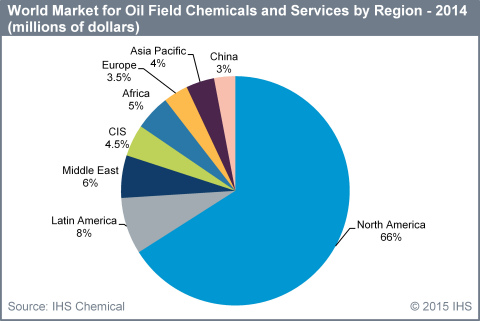LONDON--(BUSINESS WIRE)--Driven in large part by the rapid expansion of shale oil and gas drilling and production in North America, the world market for oil field specialty chemicals at the service company level reached $25 billion in 2014, up from nearly $16 billion in 2010, but significant declines in oil price have dampened the demand outlook for oil field chemicals for the 2015 to 2019 period, according to a new global market study from IHS (NYSE: IHS), the leading global source of information and analysis.
The IHS Chemical 2015 Specialty Chemicals Update Report - Oil Field Chemicals covers historical developments and future projections for supply, demand, capacity and trade in the global oil field chemicals markets for 2015 to 2019, and projects sales of oil field chemicals will grow annually at a rate of approximately 4 percent to more than $30 billion in 2019, based on volume growth and price changes in effect at the end of 2014.
“During the past five years, we saw unprecedented market growth for oil field chemicals, which has been driven by the rapid development and production of shale oil and gas resources in North America,” said Stefan Schlag, director of inorganic chemicals and mineral and mining products at IHS Chemical and lead author of the report. “We expect demand for these chemicals to continue to grow, but at a much slower rate than in the previous period.”
Oil field chemicals typically fall under three categories: drilling fluids, cementing and stimulation, and oil production. Drilling muds and fluids are chemical systems used to lubricate the drill bit, to control formation pressure, and to remove formation cuttings. They can be oil- or water-based depending on the geologic formation. Cementing uses chemicals to cement steel pipes or casing to the sides of the borehole.
Stimulation chemicals encourage the flow of crude oil to the well. Two commonly used stimulation techniques are acidizing and fracturing — an essential part of hydraulic fracturing. And finally, oil production chemicals are used at all stages from oil production at the wellbore to delivery of crude to the refinery. Products include corrosion and scale inhibitors, biocides and demulsifiers.
Said Schlag, “IHS doesn’t expect lower oil prices to have a major impact on sales of chemicals to the production segment, but we expect lower prices will likely have more of an impact on sales of chemicals for drilling, stimulation and completion activities. The primary reason for this is that actual oil production volumes are expected to continue to increase—in line with expected continued growth of world crude oil demand. However, lower crude oil prices have slowed exploration drilling and the drilling of new boreholes, especially for more complex unconventional and deepwater oil projects. These projects typically have higher production costs, and are in many cases, not economic at current oil prices.”
Despite the year-end slowdown in E&P activity driven by the oil price slide, hydraulic fracturing continued globally in 2014, but primarily in North America. In 2014, total chemical consumption related to fracking was valued at nearly $8.6 billion, with the U.S. and Canada accounting for the lion’s share of demand at $8 billion, or approximately 94 percent of total world consumption of stimulant chemicals.
Latin America was a distant second in terms of demand for oil field chemicals, accounting for slightly less than 9 percent of global demand or $2.2 billion of sales. The Middle East followed with 8 percent of global oil field chemical demand or $2 billion in sales. The CIS followed, with 6.5 percent of global demand for these chemicals or $1.6 billion in sales.
Said Schlag, “It may seem counterintuitive, but markets for oil production chemicals show almost no correlation with regional, raw oil production volumes. In fact, rather than production volumes, it is the complexity of the oil production process itself (conventional, deep water or unconventional) -- that has a large impact on the demand for oil field chemicals.”
The global oil field chemicals industry is dominated by three oil field services companies—Schlumberger, Halliburton and Baker Hughes, and these companies are becoming larger through acquisitions, which will allow them to offer a wider range of oil field services such as exploration, drilling, design and engineering. Despite the expected near-term market volatility for specialty chemicals, the oil field services sector saw significant merger and acquisition activity at the end of 2014, with Halliburton announcing the largest deal--a $35 billion acquisition of Baker Hughes in November. That deal is expected to close in the second half of 2015, pending U.S. government approval.
Prior to the acquisition announcement, Schlumberger led the oil field services sector, including oil field chemicals sales, with total 2014 sales exceeding $48 billion, or more than 46 percent of the total oil field services market, followed by Halliburton at slightly more than $32 billion in sales in 2014, or nearly 31 percent of market share. Baker Hughes followed in third position at nearly $24 billion in 2014 sales, or almost 23 percent of the market. Based on 2014 market share figures, a combined Halliburton and Baker Hughes would dominate the oil field services market with slightly less than 54 percent of global market share.
To speak with Stefan Schlag, please contact Katarzyna Kosior at katarzyna.kosior@ihs.com. For more information on the IHS Chemical 2015 Specialty Chemicals Update Report - Oil Field Chemicals, please contact Nisha Keskar at nisha.keskar@ihs.com.
About IHS (www.ihs.com)
IHS (NYSE: IHS) is the leading source of information, insight and analytics in critical areas that shape today’s business landscape. Businesses and governments in more than 165 countries around the globe rely on the comprehensive content, expert independent analysis and flexible delivery methods of IHS to make high-impact decisions and develop strategies with speed and confidence. IHS has been in business since 1959 and became a publicly traded company on the New York Stock Exchange in 2005. Headquartered in Englewood, Colorado, USA, IHS is committed to sustainable, profitable growth and employs more than 8,800 people in 32 countries around the world.
IHS is a registered trademark of IHS Inc. All other company and product names may be trademarks of their respective owners. © 2015 IHS Inc. All rights reserved.




